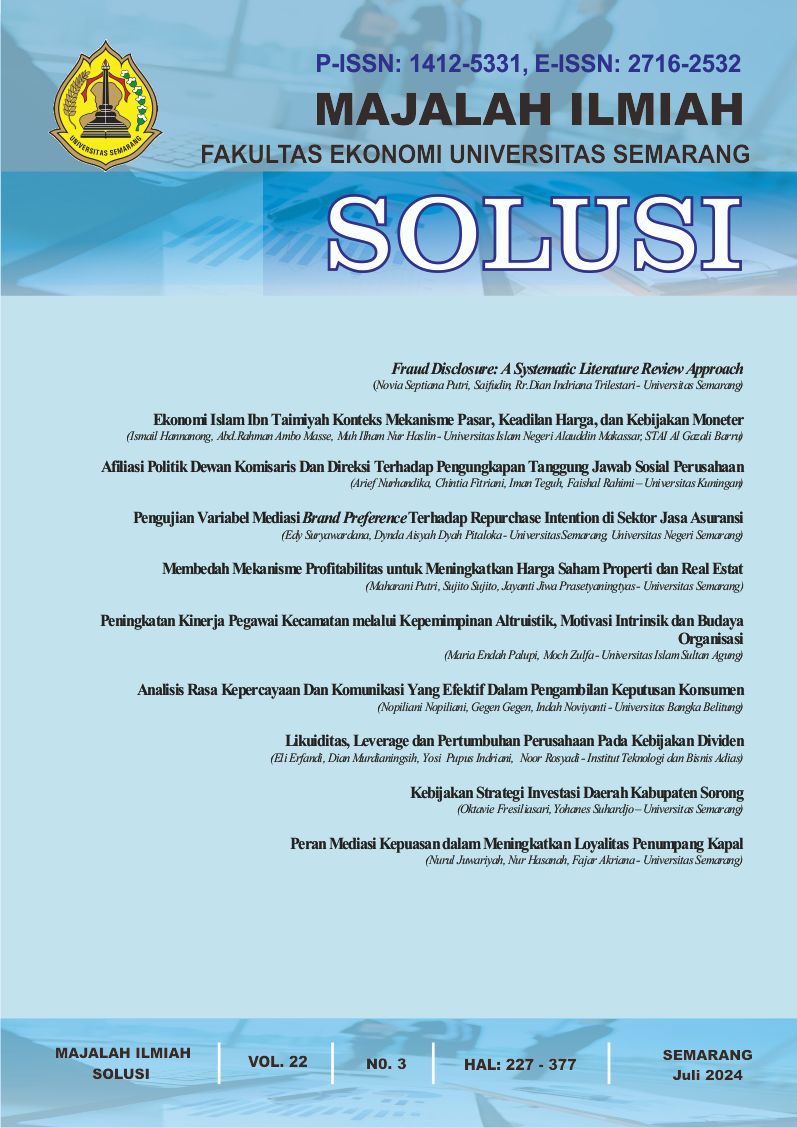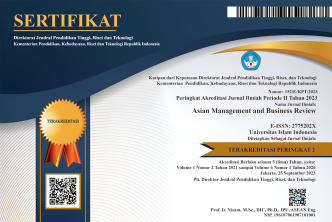Pengujian Variabel Mediasi Brand Preference Terhadap Repurchase Intention di Sektor Jasa Asuransi
DOI:
https://doi.org/10.26623/slsi.v22i3.9155Keywords:
Repurchase intention, Switching Cost, Brand Preference, Perceived Value, Customer AttitudeAbstract
Persaingan bisnis asuransi semakin ketat dari waktu ke waktu. Pelanggan senantiasa akan membeli produk-produk asuransi yang dapat memberikan jaminan yang baik. Repurchase intention sering dimaknai sebagai keinginan pelanggan membeli ulang komoditas atau jasa yang ditawarkan di pasar. Kualitas pelayanan yang lebih ditekankan oleh pelanggan pada perusahaan asuransi berhubungan dengan layanan penjualan dan pemasaran, kemampuan R & D dan layanan inovatif terhadap kesediaan pelanggan untuk membeli kembali produk asuransi. Banyak hal yang mempengaruhi repurchase intention diantaranya perceived value, expected switching cost dan brand preference. Tujuan penelitian ini adalah menganalisis variabel mediasi brand preference terhadap pengaruh perceived value dan expected switching cost pada repurchase intention yang sekaligus menawarkan model empiris yang mengangkat variabel unik dalam bidang perusahaan jasa asuransi. Populasi dan sampel yang digunakan adalah pelanggan yang membeli produk asuransi di Indonesia berjumlah 269 dengan teknik purposive sampling. Metode pengumpulan data menggunakan kuesioner. Teknik analisis menggunakan SEM dengan software AMOS. Hasil analisis membuktikan: 1). Perceived value mempengaruhi brand preference. 2). Perceived value mempengaruhi repurchase intention. 3). Expected switching cost mempengaruhi brand preference. 4). Expected switching cost mempengaruhi repurchase intention. 5). Brand preference mempengaruhi repurchase intention. Penelitian ini memberikan kontribusi yang positif kepada perusahaan asuransi agar senantiasa mempertahankan kepercayaan konsumen dan memberikan pelayanan terbaiknya sehingga konsumen selalu berminat membeli ulang produk-produk asuransi.
References
Ahalya, U., & Geetha, B. (2019). A Study on Consumers Brand Preference Towards Mobile Phones. Journal of Emerging Technologies and Innovative Research (JETIR), 6(3), 67–73.
Ahmatang, Ningrum, W. S., Apriadi, D., & Suryaningsih. (2023). Product Quality, Service Quality and Tupperware Brand Preference for Repurchase Interests. International Journal of Management and Business Applied, 2(1), 1–11. https://doi.org/10.54099/ijmba.v2i1.510
Aydin, S., & Özer, G. (2005). The analysis of antecedents of customer loyalty in the Turkish mobile telecommunication market. European Journal of Marketing, 39(7–8), 910–925. https://doi.org/10.1108/03090560510601833
Bergel, M., & Brock, C. (2018). The impact of switching costs on customer complaint behavior and service recovery evaluation. Journal of Service Theory and Practice, 28(4), 458–483. https://doi.org/10.1108/JSTP-02-2017-0035
Bernarto, I., Purwanto, A., Tulung, J. E., & Pramono, R. (2024). The Influence of Perceived Value, And Trust on Wom and Its Impact on Repurchase Intention. Revista de Gestão Social e Ambiental, 18(4), e04983. https://doi.org/10.24857/rgsa.v18n4-081
Blazquez, D., & Domenech, J. (2018). Big Data sources and methods for social and economic analyses. Technological Forecasting and Social Change, 130(March), 99–113. https://doi.org/10.1016/j.techfore.2017.07.027
Buil, I., Martínez, E., & de Chernatony, L. (2013). The influence of brand equity on consumer responses. Journal of Consumer Marketing, 30(1), 62–74. https://doi.org/10.1108/07363761311290849
Burnham, T. A., Frels, J. K., & Mahajan, V. (2003). Consumer switching costs: A typology, antecedents, and consequences. Journal of the Academy of Marketing Science, 31(2), 109–126. https://doi.org/10.1177/0092070302250897
Chansuk, S., & Chaipoopirutana, S. (2020). An Integrated Model of Influence of Perceived Quality , Perceived Value , Brand Association , Brand Awareness and Brand Uniqueness on Brand Loyalty Towards a Luxury Brand in Bangkok , Thailand . Enterpreneurship and Sustainability in the Digital Era, 1(1), 13. http://www.assumptionjournal.au.edu/index.php/icesde/articel/view/5034
De Toni, D., Eberle, L., Larentis, F., & Milan, G. S. (2018). Antecedents of Perceived Value and Repurchase Intention of Organic Food. Journal of Food Products Marketing, 24(4), 456–475. https://doi.org/10.1080/10454446.2017.1314231
Dharmaraj, C. (2010). Impact of brand preference dimensions on customer satisfaction - A meta analysis for passenger cars. Indian Journal of Marketing, 40(11), 28–35.
Dias, R. P., & Kusuma, N. I. (2023). The Effect of Brand Identity and Brand Preference on Starbucks Repurchase Interest in Bekasi City. Jurnal Ekonomi Dan Bisnis Digital, 2(3), 1031–1054. https://doi.org/10.55927/ministal.v2i3.4207
Dlačić, J., Arslanagić, M., Kadić-Maglajlić, S., Marković, S., & Raspor, S. (2014). Exploring perceived service quality, perceived value, and repurchase intention in higher education using structural equation modelling. Total Quality Management and Business Excellence, 25(1–2), 141–157. https://doi.org/10.1080/14783363.2013.824713
Dubé, J. P., Hitsch, G. J., & Rossi, P. E. (2009). Do switching costs make markets less competitive? Journal of Marketing Research, 46(4), 435–445. https://doi.org/10.1509/jmkr.46.4.435
Ferdinand, A. . (2000). Structural Equation Modelling Dalam Penelitian Manajemen. BP Undip Seamarang.
Goh, S. K., Jiang, N., Hak, M. F. A., & Tee, P. L. (2016). Determinants of smartphone repeat purchase intention among Malaysians: A moderation role of social influence and a mediating effect of consumer satisfaction. International Review of Management and Marketing, 6(4), 993–1004.
Hellier, P. K., Geursen, G. M., Carr, R. A., & Rickard, J. A. (2003). Customer repurchase intention. European Journal of Marketing, 37(11/12), 1762–1800. https://doi.org/10.1108/03090560310495456
Ho, S. P. S., & Chow, M. Y. C. (2023). The role of artificial intelligence in consumers’ brand preference for retail banks in Hong Kong. Journal of Financial Services Marketing, 0123456789. https://doi.org/10.1057/s41264-022-00207-3
Huang, L. C., Gao, M., & Hsu, P. F. (2019). A study on the effect of brand image on perceived value and repurchase intention in ecotourism industry. Ekoloji, 28(107), 283–287.
Hume, M., Mort, G. S., & Winzar, H. (2007). Exploring repurchase intention in a performing arts context: who comes? and why do they come back? International Journal of Nonprofit and Voluntary Sector Marketing, 12(2), 135–148. https://doi.org/10.1002/nvsm.284
Hwang, J., Joo, K. H., Kim, H. M., & Lee, K. W. (2024). Technological change in the context of robotic coffee shops: focusing on consumer innovativeness. Journal of Hospitality and Tourism Technology, 15(1), 37–53. https://doi.org/10.1108/JHTT-02-2023-0051
Jacob, M. R., & Berlianto, M. P. (2022). The Determinant Factors that Influence Repurchase Intention of Samsung Smartphone in Jabodetabek. Enrichment: Journal of Management, 12(4), 2678–2689.
Jin, N., Lee, K. H., & Lee, S. M. (2022). Customer loyalty in the kids café business: the role of relationship benefits. Journal of Foodservice Business Research, 27(1), 87–107. https://doi.org/10.1080/15378020.2022.2058313
Kim, N., & Ulgado, F. M. (2012). The effect of on-the-spot versus delayed compensation: The moderating role of failure severity. Journal of Services Marketing, 26(3), 158–167. https://doi.org/10.1108/08876041211223960
Kyriazos, T. A. (2018). Applied Psychometrics: Sample Size and Sample Power Considerations in Factor Analysis (EFA, CFA) and SEM in General. Psychology, 09(08), 2207–2230. https://doi.org/10.4236/psych.2018.98126
Lee, J., Lee, J., & Feick, L. (2001). The impact of switching costs on the customer satisfaction-loyalty link: Mobile phone service in France. Journal of Services Marketing, 15(1), 35–48. https://doi.org/10.1108/08876040110381463
Li, M., Hua, Y., & Zhu, J. (2021). From interactivity to brand preference: The role of social comparison and perceived value in a virtual brand community. Sustainability (Switzerland), 13(2), 1–17. https://doi.org/10.3390/su13020625
Ligaraba, N., Cheng, J., Ndungwane, N. F., & Nyagadza, B. (2024). Brand authenticity influence on young adults’ luxury sneakers brand preference: the mediating role of brand image. Future Business Journal, 10(1). https://doi.org/10.1186/s43093-024-00312-w
Liu, B., Xu, J., Guo, Y., & Fu, Y. (2024). How the perceived value of green creativity influences employees’ green creativity: the dual promotion–prevention path. Journal of Sustainable Tourism, 32(1), 132–150. https://doi.org/10.1080/09669582.2022.2126489
Liu, J. (2020). An investigation on the Influence of Service quality , Trust , Satisfaction on Online Repurchase Intention and Willingness to Recommend in China. Au Virtual International Conference 2020: Entrepreneurship and Sustainability in the Digital Era, 158–171.
Loureiro, S. M. C., Dias Sardinha, I. M., & Reijnders, L. (2012). The effect of corporate social responsibility on consumer satisfaction and perceived value: The case of the automobile industry sector in Portugal. Journal of Cleaner Production, 37, 172–178. https://doi.org/10.1016/j.jclepro.2012.07.003
Mannan, M., Mohiuddin, M. F., Chowdhury, N., & Sarker, P. (2017). Customer satisfaction, switching intentions, perceived switching costs, and perceived alternative attractiveness in Bangladesh mobile telecommunications market. South Asian Journal of Business Studies, 6(2), 142–160. https://doi.org/10.1108/SAJBS-06-2016-0049
Mohajan, H. (2020). Munich Personal RePEc Archive Quantitative Research: A Successful Investigation in Natural and Social Sciences. In Journal of Economic Development, Environment and People (Vol. 9, Issue 4). https://mpra.ub.uni-muenchen.de/105149/
Namin, A. (2017). Revisiting customers’ perception of service quality in fast food restaurants. Journal of Retailing and Consumer Services, 34(September 2016), 70–81. https://doi.org/10.1016/j.jretconser.2016.09.008
Natalia, J., & Kaihatu, T. S. (2023). ANALYSIS OF FACTORS INFLUENCING REPURCHASE DECISION AT RULYPRINT PRINTING SERVICES. International Journal of Review Management, Business, e-ISSN 2797-9237 and Entrepreneurship, 3(2), 55–62.
Paidi, S. (2024). Prospek Industri Asuransi Jiwa di Indonesia. Economic Review, 2(1), 1–13.
Peng, N., Chen, A., & Hung, K. P. (2017). The effects of teppanyaki restaurant stimuli on diners’ emotions and loyalty. International Journal of Hospitality Management, 60, 1–12. https://doi.org/10.1016/j.ijhm.2016.09.010
Pick, D., & Eisend, M. (2016). Customer responses to switching costs: A meta-analytic investigation of the moderating influence of culture. Journal of International Marketing, 24(4), 39–60. https://doi.org/10.1509/jim.15.0139
Rai, N., & Thapa, B. (2019). A study on purposive sampling method in research. Kathmandu:Kathmandu School of Law, 1–12. http://stattrek.com/survey-research/sampling-methods.aspx?Tutorial=AP,%0Ahttp://www.academia.edu/28087388
Rambitan, T. F. (2013). the Effect of Perceived Value and Brand Experience on. Journal EMBA, 1(4), 1–10.
Rawis, S. O., Nasution, R. A., Hadiansyah, L. S., Adiani, W., & Aprianingsih, A. (2022). Systematic Literature Review of Switching Behavior in Service Industry. Binus Business Review, 13(1), 1–17. https://doi.org/10.21512/bbr.v13i1.7618
Raza, M., Khalid, R., Loureirco, S. M. C., & Han, H. (2024). Luxury brand at the cusp of lipstick effects: Turning brand selfies into luxury brand curruncy to thrive via richcession. Journal of Retailing and Consumer Services, 79(March), 103850. https://doi.org/10.1016/j.jretconser.2024.103850
Richards, T. J., & Liaukonytė, J. (2023). Switching cost and store choice. American Journal of Agricultural Economics, 105(1), 195–218. https://doi.org/10.1111/ajae.12307
Russo, I., Confente, I., Gligor, D. M., & Cobelli, N. (2017). The combined effect of product returns experience and switching costs on B2B customer re-purchase intent. Journal of Business and Industrial Marketing, 32(5), 664–676. https://doi.org/10.1108/JBIM-06-2016-0129
Sharif, S., Rehman, S. U., Ahmad, Z., Albadry, O. M., & Zeeshan, M. (2024). Consumer quality management for beverage food products: analyzing consumer’ perceptions toward repurchase intention. TQM Journal, 36(2), 431–459. https://doi.org/10.1108/TQM-01-2022-0012
Sharma, N., & Fatima, J. (2024). Influence of perceived value on omnichannel usage: Mediating and moderating roles of the omnichannel shopping habit. Journal of Retailing and Consumer Services, 77(November 2023), 103627. https://doi.org/10.1016/j.jretconser.2023.103627
Sohaib, M. (2022). An Investigation of Repurchase Intentions in the Banking Industry: What Reason Do They Return? SAGE Open, 12(1). https://doi.org/10.1177/21582440211067228
Sullivan, Y. W., & Kim, D. J. (2018). Assessing the effects of consumers’ product evaluations and trust on repurchase intention in e-commerce environments. International Journal of Information Management, 39(December 2017), 199–219. https://doi.org/10.1016/j.ijinfomgt.2017.12.008
Sultan, F., Setiawati, L., & Bandung, P. N. (2024). An Investigation in Understanding the Influence of Brand Preferences on Purchase Intention : Examples of Indonesian W e A a el B a d. 1, 26–41.
Theresia, S., & Antonio, F. (2024). Study of Social Media Marketing of A Local Snack Brand Toward Brand Authenticity and its Impact on Brand Preference. International Journal of Economics Development Research, 5(1), 351–368.
Tian, H., Siddik, A. B., & Masukujjaman, M. (2022). Factors Affecting the Repurchase Intention of Organic Tea among Millennial Consumers: An Empirical Study. Behavioral Sciences, 12(2). https://doi.org/10.3390/bs12020050
Tresna, P. W., Suryanto, & Haidysirly, H. (2019). Effect of perceived value on repurchase intention in e-commerce: A study on the Female Daily mobile application. International Journal of Trade and Global Markets, 12(3–4), 373–380. https://doi.org/10.1504/IJTGM.2019.101560
Tri Cuong, D. (2023). Determinants affecting online shopping consumers’ satisfaction and repurchase intention: Evidence from Vietnam. Innovative Marketing, 19(1), 126–139. https://doi.org/10.21511/im.19(1).2023.11
Trung, Q., Id, P., Tran, X. P., & Misra, S. (2018). Relationship between Convenience , Perceived Value , and Repurchase Intention in Online Shopping in Vietnam. Mdpi, 10(156), 1–14. https://doi.org/10.3390/su10010156
Tsai, H. T., & Huang, H. C. (2007). Determinants of e-repurchase intentions: An integrative model of quadruple retention drivers. Information and Management, 44(3), 231–239. https://doi.org/10.1016/j.im.2006.11.006
Wang, E. S. T. (2015). Effect of food service-brand equity on consumer-perceived food value, physical risk, and brand preference. British Food Journal, 117(2), 553–564. https://doi.org/10.1108/BFJ-09-2013-0260
Willys, N. (2018). Customer Satisfaction, Switching Costs and Customer Loyalty: An Empirical Study on the Mobile Telecommunication Service. American Journal of Industrial and Business Management, 08(04), 1022–1037. https://doi.org/10.4236/ajibm.2018.84070
Wu, T., Jiang, N., Kumar, T. B. J., & Chen, M. (2024). The role of cognitive factors in consumers’ perceived value and subscription intention of video streaming platforms: a systematic literature review. Cogent Business and Management, 11(1). https://doi.org/10.1080/23311975.2024.2329247
Zhang, C. (2016). On Graphic Design in Visual Packaging Design. Pertanika, 26(August), 297–306. https://doi.org/10.2991/icadce-16.2016.155
Buku :
Hair, J., Black, W., Babin, B., Anderson, R. (2010). Multivariate Data Analysis: A Global Perspective. Pearson, New Jersey.
Otoritas Jasa Keuangan. (2023). Draft Roadmap Pengembangan Perasuransian Indonesia. Departemen Pengaturan Dan Pengembangan IKNB, OJK, 1–63.
Downloads
Additional Files
Published
Issue
Section
License
The author who will publish the manuscript at Solusi : Journal of Solusi, agree to the following terms:
|
















